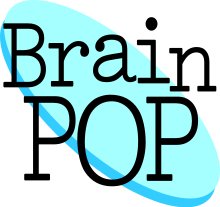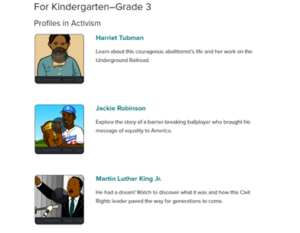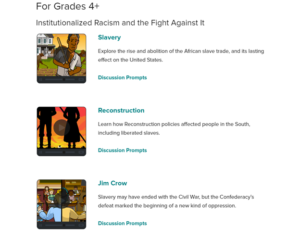 by Tess Butler-Ulrich (writing & research)
by Tess Butler-Ulrich (writing & research)
and Bradley Nicholas (research)
BrainPOP is a free multimodal learning platform developed with the aim of making typically complex educational concepts understandable and engaging for students. Available as both an app and browser-based site, BrainPOP offers a variety of units, quizzes, videos, and resources that support both core and supplemental subjects.
Recently, BrainPOP has developed anti-racist resources that have been added to its comprehensive catalogue of educational offerings.
These anti-racist resources, typically historical in context, can provide teachers with a  starting point in teaching for social justice. BrainPOP has divided its resources into two age categories: K – 3 and Grade 4+. The K – 3 selection is comprised of Profiles in Activism. These profiles allow young learners to explore significant figures in American history that played an important role in the ongoing fight for racial equality. Each profile includes accompanying quizzes, word games, and supporting consolidation activities that allow children to further explore these topics within a wide variety of contexts (e.g., through songs, drawings, comparisons).
starting point in teaching for social justice. BrainPOP has divided its resources into two age categories: K – 3 and Grade 4+. The K – 3 selection is comprised of Profiles in Activism. These profiles allow young learners to explore significant figures in American history that played an important role in the ongoing fight for racial equality. Each profile includes accompanying quizzes, word games, and supporting consolidation activities that allow children to further explore these topics within a wide variety of contexts (e.g., through songs, drawings, comparisons).
The Grade 4+ resources are formatted similarly, but the breadth and scope of the topics are more advanced in nature, with the specific focus on systemic and institutionalized racism in America. There are also added discussion prompts, which can be used to  facilitate meaningful dialogue around subjects that some teachers may otherwise avoid.
facilitate meaningful dialogue around subjects that some teachers may otherwise avoid.
BrainPOP’s featured anti-racist resources are a great way to introduce activism and anti-racist education to the classroom by investigating the historical context of racism. However, it is key to remember that racism does not exist solely in the past, and that systemic racism is still embedded within our society today. Though focusing on historical racism and the roots of oppression in Canada and America is imperative to building a foundation for anti-racism in the classroom, the work does not (and can no longer) stop there. Teachers must ensure that anti-racist education is not a temporary or fleeting topic in class, nor can racism only be examined through a historical lens. Instead, we must work to build an overarching framework for anti-racism so that it permeates each facet of the class, rather than using anti-racism resources to “check the box” of social justice or anti-racist education. It is not enough to implement a lesson or two with a historical focus. Students need the opportunity to critically investigate racism as both a historical and current issue in Canada, as well as to participate in on-going dialogue in the classroom. To achieve this, teachers must be aware that part of being actively anti-racist is through action and sustained education (of both our students and ourselves). Using anti-racism resources like those provided by BrainPOP is simply one stepping stone on the path to meaningful anti-racist education.


